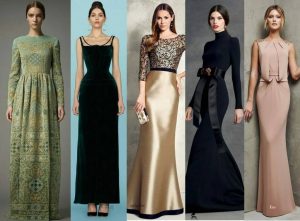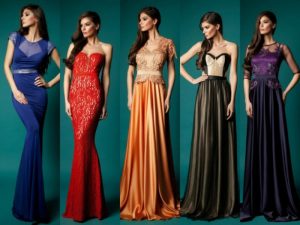Types of evening dresses for a party
An evening party dress is a type of formal dress that is typically worn to a special event or occasion such as a wedding, gala, or ball. Evening party dresses come in a variety of styles, colors, and fabrics, and the choice of dress will depend on the formality of the event, personal preference, and body shape.
Here are some tips for choosing an evening party dress:
- Consider the dress code: The dress code will give you a good idea of what type of dress is appropriate. If the event is black tie, a full-length formal gown is appropriate, while a cocktail dress is more appropriate for a semi-formal event.
- Choose a dress that flatters your body type: Consider your body shape and choose a dress that accentuates your best features. For example, a dress with a cinched waist and a flowing skirt can be flattering for an hourglass figure, while an A-line dress can be flattering for a pear-shaped figure.
- Choose a color that complements your skin tone: Consider your skin tone when choosing a color for your dress. Colors like navy, emerald green, and burgundy can be flattering on most skin tones, while pastel colors may be better suited for lighter skin tones.
- Consider the fabric: Choose a fabric that is comfortable to wear and appropriate for the occasion. For a formal event, silk, satin, or chiffon can be appropriate, while for a more casual event, cotton or jersey fabric may be more appropriate.
- Accessorize appropriately: Choose accessories that complement your dress and the occasion. For a formal event, opt for elegant jewelry and a clutch purse, while for a more casual event, opt for more relaxed accessories.
Overall, choosing an evening party dress is all about finding a dress that makes you feel confident, comfortable, and beautiful.
Consider the dress code
When attending an event or occasion, it’s important to consider the dress code to ensure that you are appropriately dressed. Dress codes can vary from casual to formal, and the specific dress code will depend on the type of event or occasion. Here are some common dress codes and what they entail:
- Casual: This dress code is the most relaxed, and usually means you can wear comfortable, everyday clothing. However, it’s still https://www.buydo.eu important to look neat and put-together. Examples of appropriate outfits for a casual dress code include jeans, a blouse or shirt, and comfortable shoes.
- Business Casual: This dress code is commonly used for work or business-related events. It’s a step up from casual and usually requires more polished and professional attire. Examples of appropriate outfits for a business casual dress code include slacks, a dress shirt or blouse, and dress shoes.
- Cocktail: This dress code is typically used for semi-formal events or parties, and usually requires a dress or dressy separates. The dress should be knee-length or just above, and can be in a variety of styles and colors. Dressy heels or dressy flats are appropriate for this dress code.
- Formal or Black Tie: This dress code is the most formal and requires formal attire. For men, this usually means a tuxedo or dark suit, while for women, it means a full-length gown or a formal cocktail dress. High heels or dressy flats are appropriate for this dress code.
- White Tie: This is the most formal dress code, reserved for very formal events such as balls or galas. For men, this requires a tailcoat, while for women, it requires a formal full-length gown, gloves, and formal jewelry.

Choose a dress that flatters your body type:
- Apple Shape: If you have an apple-shaped body, choose dresses with an empire waistline, A-line or flowy skirts, and V-necklines to create a balanced look.
- Pear Shape: If you have a pear-shaped body, choose dresses with a fitted bodice, A-line or flared skirts, and off-the-shoulder or boat necklines to draw attention to your upper body.
- Hourglass Shape: If you have an hourglass-shaped body, choose dresses with a fitted silhouette that accentuates your curves, such as bodycon or wrap dresses.
- Rectangle Shape: If you have a rectangle-shaped body, choose dresses that create the illusion of curves, such as dresses with a cinched waist, peplum or ruffle details, and sweetheart or scoop necklines.
- Inverted Triangle Shape: If you have an inverted triangle-shaped body, choose dresses with a V-neckline, A-line or flowy skirts, and details at the hemline to balance out your broad shoulders.
Choose a color that complements your skin tone:
Choosing a color that complements your skin tone can enhance your overall appearance. Here are some general tips to consider:
- Cool skin tone: If you have a cool skin tone, you may have pink or blue undertones. Colors that complement cool skin tones include jewel tones such as emerald, sapphire, and ruby, as well as cool shades of pink, purple, and blue.
- Warm skin tone: If you have a warm skin tone, you may have yellow or golden undertones. Colors that complement warm skin tones include earthy shades such as olive, rust, and terracotta, as well as warm shades of red, orange, and yellow.
- Neutral skin tone: If you have a neutral skin tone, you may have a mix of cool and warm undertones. Colors that complement neutral skin tones include muted shades of pink, purple, and blue, as well as earthy shades of green and brown.
It’s important to note that these are just general guidelines, and ultimately, the best color for you is the one that makes you feel confident and comfortable.
Consider the fabric:
Considering the fabric of a garment is important as it can affect the comfort, durability, and overall appearance of the piece. Here are some general tips to consider when choosing a fabric:
- Cotton: Cotton is a breathable and versatile fabric that is ideal for everyday wear. It is easy to care for and can be machine washed.
- Silk: Silk is a luxurious fabric that is lightweight and has a soft and smooth texture. It is ideal for special occasions but can be delicate and require special care.
- Wool: Wool is a warm and durable fabric that is perfect for cold weather. It can be itchy for some people, so it’s best to try it on before purchasing.
- Polyester: Polyester is a synthetic fabric that is durable and easy to care for. It can be used for a variety of garments and is often blended with other fabrics.
- Linen: Linen is a breathable and lightweight fabric that is perfect for summer. It has a textured appearance and can wrinkle easily.
- Denim: Denim is a durable and versatile fabric that is ideal for casual wear. It can be used for jeans, jackets, and skirts.
It’s important to consider the occasion, climate, and personal preferences when choosing a fabric.
Accessorize appropriately:
Accessories can enhance an outfit and add a personal touch to your style. Here are some general tips to consider when accessorizing:
- Consider the occasion: The occasion should dictate the type of accessories you wear. For example, statement jewelry and high heels may be appropriate for a formal event, while a simple necklace and flats may be better for a casual outing.
- Balance is key: It’s important to balance the accessories with the outfit. If you are wearing a busy pattern or bold colors, keep the accessories minimal. If the outfit is simple, add a statement piece of jewelry or a colorful scarf to add interest.
- Don’t overdo it: Too many accessories can overwhelm an outfit. Stick to a maximum of three accessories to avoid looking cluttered.
- Pay attention to color and texture: Accessories should complement the outfit in terms of color and texture. A neutral outfit can be livened up with a colorful scarf or a statement bag, while a textured outfit can be balanced with simple and sleek accessories.
- Consider the fit: Accessories should be proportionate to the outfit and the person wearing them. For example, a petite person may be overwhelmed by large statement jewelry, while a tall person may need larger accessories to balance their height.
Ultimately, accessories should reflect your personal style and make you feel confident and comfortable.
Choosing an evening dress for a party
When choosing an evening dress for a party, it’s important to consider the occasion, dress code, and your personal style. Here are some general tips to consider:
- Consider the dress code: The dress code should dictate the type of dress you wear. If the event is black-tie, a formal gown is appropriate. For a cocktail party, a knee-length dress or dressy separates may be more appropriate.
- Choose a flattering silhouette: Choose a dress silhouette that flatters your body type and makes you feel confident. Some popular evening dress silhouettes include A-line, sheath, mermaid, and ballgown.
- Pay attention to details: The details of the dress can elevate its overall look. Consider details such as embellishments, lace, beading, and cutouts.
- Choose the right fabric: Choose a fabric that is appropriate for the occasion and climate. For a winter event, a heavier fabric such as velvet may be appropriate, while a summer event may call for a lighter fabric such as chiffon or silk.
- Accessorize appropriately: Accessorize the dress with appropriate jewelry, shoes, and a clutch. Consider the color, texture, and style of the dress when choosing accessories.
Ultimately, choose a dress that makes you feel confident and comfortable. Don’t be afraid to try on different styles and experiment with different colors and fabrics.
